MXA RACE TEST: GRAND PRIX RACING ON THE YAMAHA YZ450FX & HONDA CRF450RX
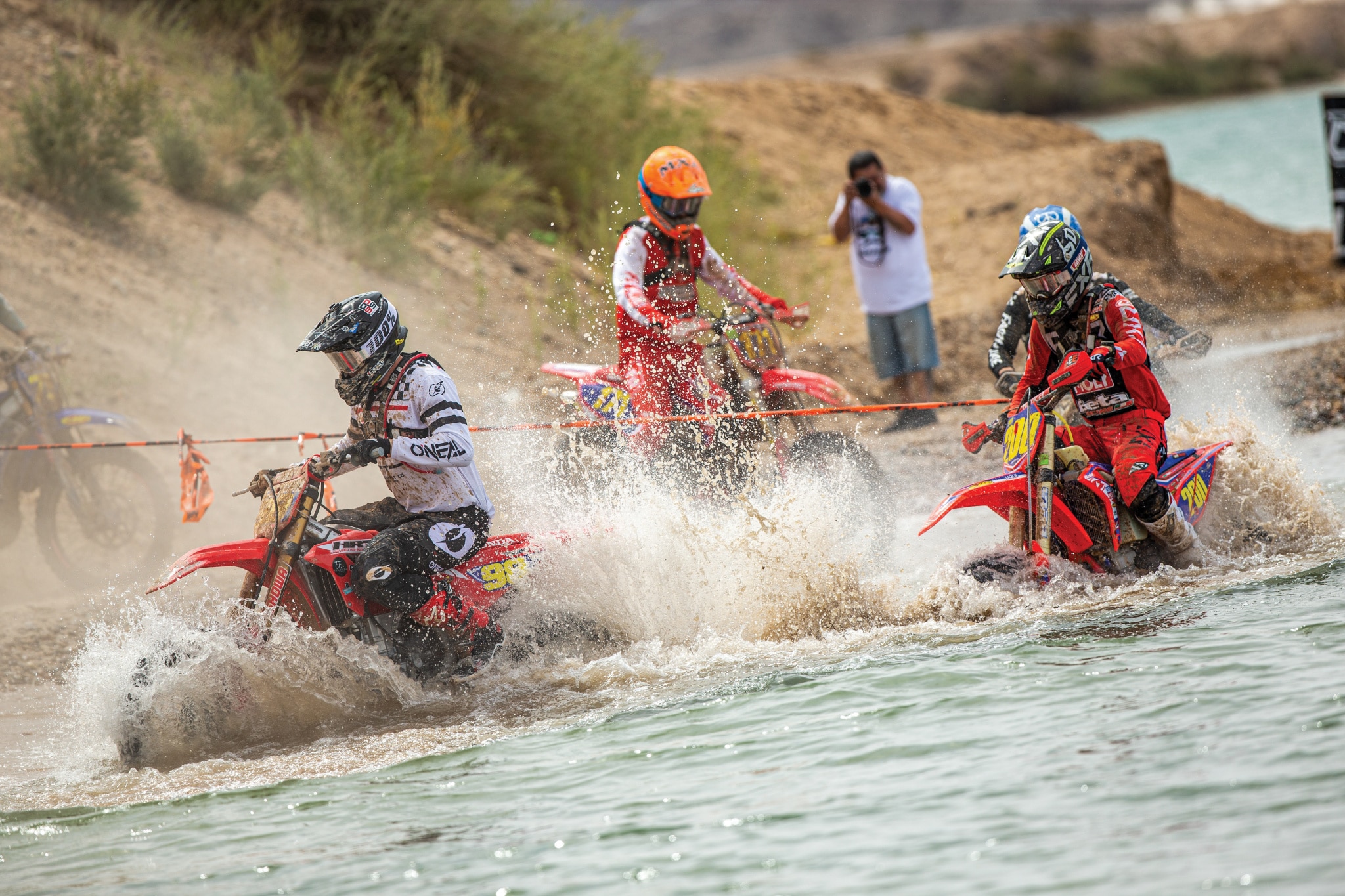 The Lake Havasu WORCS race is a five-minute-long ultra-rough motocross track with a lagoon jump; however, this year they made the Pro class ride through the lake, too.
The Lake Havasu WORCS race is a five-minute-long ultra-rough motocross track with a lagoon jump; however, this year they made the Pro class ride through the lake, too.
BY JOSH MOSIMAN (WITH PHOTOS BY CONNER MOORE)
When motorcycle racing truly began in the U.S., the lineup of bikes you could buy wasn’t like what we have today. Now we have motocross bikes, street bikes, trail bikes, trials bikes, off-road bikes, rally bikes, and the list goes on. Back then, it was up to the riders to make as many modifications as they could and then race with the end product, making the best of what they had. I’m all for the “run what you brung” mentality‚ but I wasn’t always this way, and even now I turn into a prima donna from time to time.
When you’re looking for a 450cc When we saw that the West Coast-based World Off-Road Racing Championship Series (WORCS) was scheduled to race at Lake Havasu on a free weekend for MXA, Josh and I knew it would be the perfect place to test MXA’s 2022 Yamaha YZ450FX and Honda CRF450RX cross-country bikes, even if that meant we had to jump over and ride through the lake.dirt bike, there are lots of options. The manufacturers offer multiple versions of their 450 four-strokes that come purposely set up for specific styles of racing. MXA test rider Josh Fout loves racing off-road, while I’m a motocrosser at heart. But, I sign up for a few Grands Prix every year, and Josh Fout races motocross almost every weekend.
Before I explain how the racing went, let’s dive into a condensed review of each bike, talking about their strengths and weaknesses, as well as the mods we made before we went racing.
2022 HONDA CRF450RX
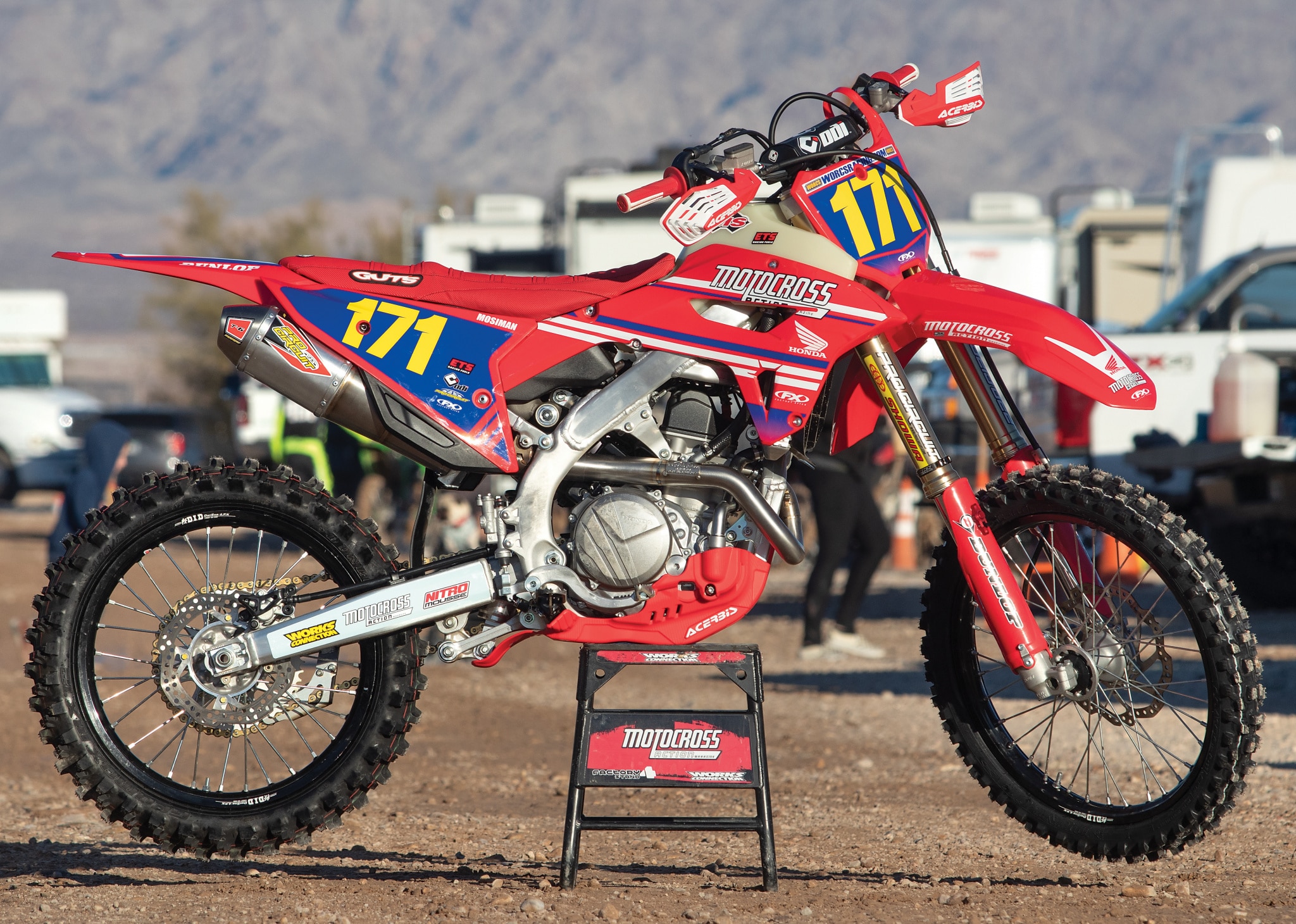 Our 2022 Honda CRF450RX underwent a small makeover before racing Lake Havasu.
Our 2022 Honda CRF450RX underwent a small makeover before racing Lake Havasu.

Q: WHAT MAKES THE 2022 HONDA CRF450RX CROSS-COUNTRY MODEL DIFFERENT FROM THE MOTOCROSS VERSION?
A: Honda makes five different competition-specific 2022 CRF450s. Isn’t that crazy? They have the standard CRF450 for motocross, the CRF450 Works Edition (a stock CRF450 with aftermarket parts), and the CRF450R-S (the exact same bike that Honda sold in 2020 with the older engine and chassis at a lower price point). Then, they have the CRF450X, which is a purpose-built off-roader developed by Baja star Johnny Campbell for Baja racing (it comes with a headlight, wide-ratio gearbox and a fuel gauge). Finally, the 2022 Honda CRF450RX (the bike we are testing) is built off the 2022 CRF450 motocross bike, but it has a few different specs that make it more “country.” Here’s a list of parts that differentiate the RX from the stock CRF450.
(1) Tank. The oversize 2.2-gallon tank is taller and wider than the stock 1.6-gallon tank.
(2) Rear wheel. It comes with the 18-inch wheel and 120/90-18 Dunlop AT81 rear tire instead of the 19-inch rear and Dunlop MX33s that come on the motocross bike.
(3) Price. The CRF450RX retails for $300 more than the CRF450—$9899.
(4) Mapping. The RX has built-in custom mapping that detunes the power, making it easier to ride.
(5) Suspension. The RX suspension has softer springs and softer valving. The forks have 5.0 N/mm in the front, while the rear spring rate is dropped from a 0.50 to a 0.48.
(6) Chain. The CRF450RX comes with a hybrid O-ring chain. It’s not a full-on heavy-duty O-ring, but it is heavier than a normal 520MX chain.
(7) Gearing. The RX has a 13/50 sprocket ratio versus the CRF450’s 13/49 ratio.
(8) Extras. For off-road use, the CRF450RX comes with a kickstand and hand guards.
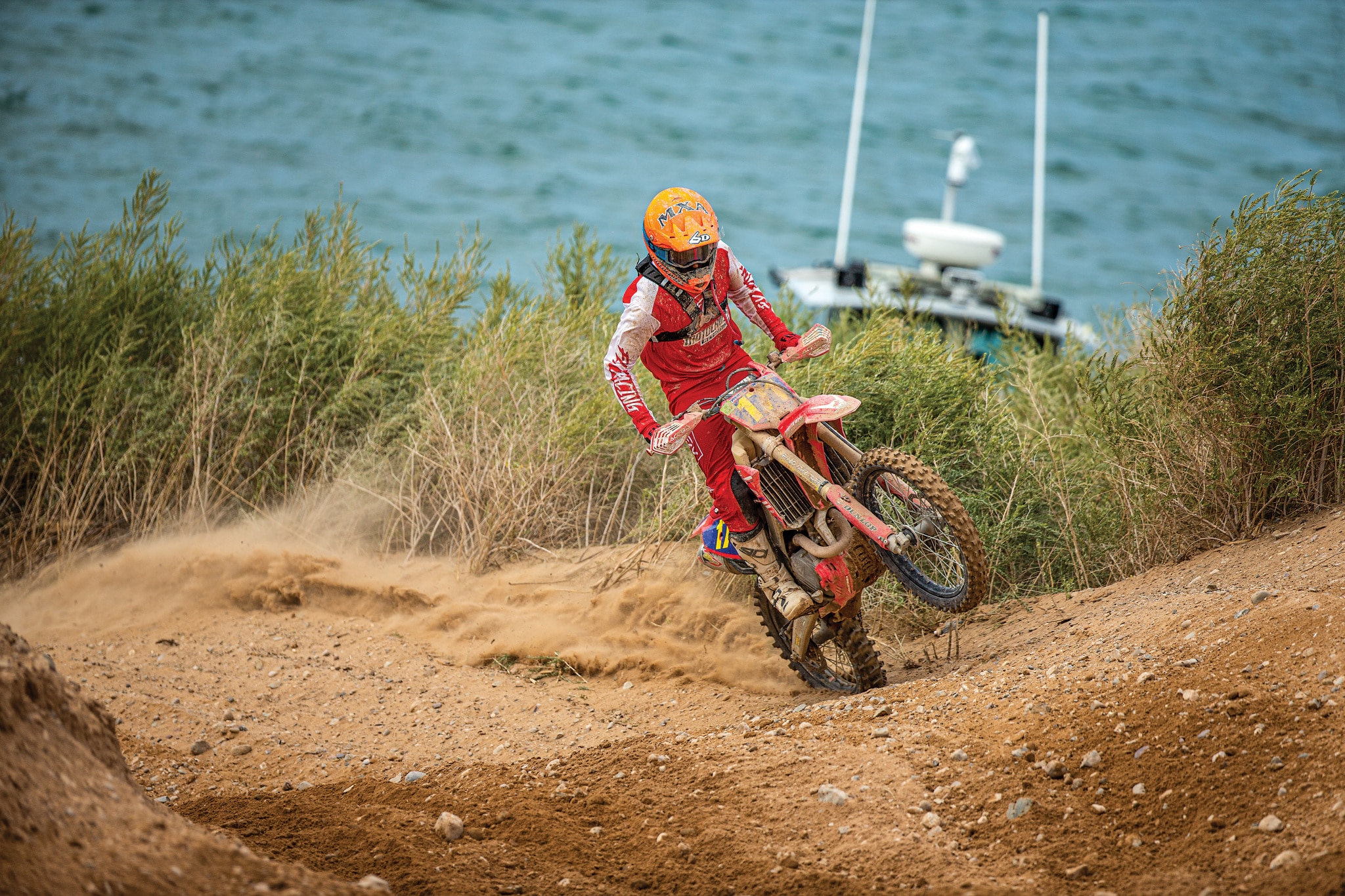 Did you know that Honda makes five different 2022 CRF450s? The RX version is set up for cross-country use with softer suspension and mellower power.
Did you know that Honda makes five different 2022 CRF450s? The RX version is set up for cross-country use with softer suspension and mellower power.
Q: WHAT ARE THE 2022 HONDA CRF450RX’S STRENGTHS?
A: The 2022 CRF450 and CRF450RX models are quick-turning machines. Precision cornering comes naturally to Honda. Even with the sag at 108mm and the forks positioned flush in the triple clamps (to position more weight on the rear end and less on the front), the 450RX was able to turn on a dime.
The power is ultra-smooth on the CRF450RX as well. The first generation 2021 CRF450 had mapping that was ratty at low rpm. It sputtered and bogged down low. Thankfully, for 2022 Honda fixed the mapping. The power on the Honda CRF450RX is very smooth. It is not as hard hitting or abrupt as the power of the 2019 or 2020 CRF450s. We like the linear power, and most of our test riders compared it to KTM’s 2022 smooth power after their first laps on it. The detuned RX mapping was certainly low on power, but we didn’t complain. A smoother and slower 450 means that you can ride it harder and longer with less fatigue, which is essential for any type of serious off-road racing.
Q: WHAT ARE THE 2022 HONDA CRF450RX’S WEAKNESSES?
A: The 2.2-gallon fuel tank is taller and wider than the stock tank. Because of its perimeter frame, the Honda doesn’t have any leftover room to go down or back, which means the tank has to go up and out to carry more petrol. This positions more weight further away from the bike’s center of gravity. With KTM’s steel frame, they can fit bigger tanks and drop the fuel further down. With Yamaha’s backward engine concept, the designers can go down and back with their tank. Both the Blue Crew and Orange Brigade have positioned their gas tanks in more favorable locations.
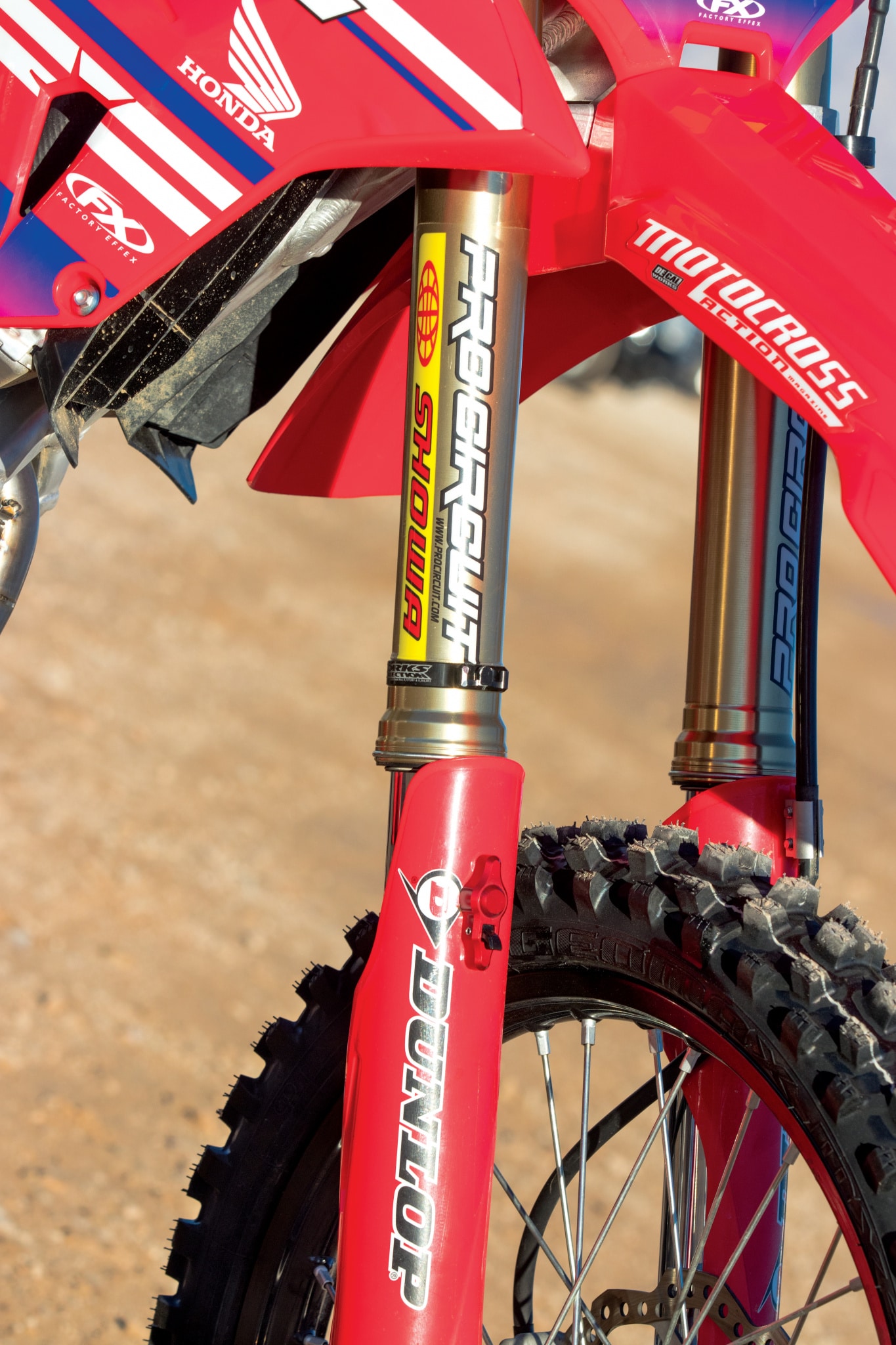 We used Pro Circuit’s JCR suspension on the Honda CRF450RX.
We used Pro Circuit’s JCR suspension on the Honda CRF450RX.
Q: WHAT DID WE MODIFY ON THE CRF450RX FOR GRAND PRIX RACING?
A: Although the CRF450RX is purpose-built for off-road racing, it wasn’t quite ready to thrive in two hours of sand whoops, which was how long the 450 Pro race was at Lake Havasu. Here’s a list of the changes we made to tune the CRF450RX for West Coast off-road racing.
(1) Suspension. The stock CRF450RX suspension is set up for a novice off-roader in the 150- to 175-pound weight range. It was too soft for me. Pro Circuit has worked closely with the Johnny Campbell Racing (JCR) Honda off-road team, and Pro Circuit set me up with slightly stiffer Grand Prix settings than Preston Campbell’s.
(2) Big tank. We switched out the 2.1-gallon stock tank for an IMS 2.6-gallon tank with a quick-fill gas cap to ensure that I’d only have to stop once during the race.
(3) Tires. After wearing them out during testing, we removed the Dunlop AT81 tires and installed a Dunlop MX33 front and a Dunlop MX12 sand/mud scoop tire on the rear. The Lake Havasu WORCS layout is half hardpack and half sand. We chose the scoop rear tire because the MX33 would just spin in the Havasu sand. While the paddle-style tire may not have liked the hardpack, it didn’t complain that much. The MX12 scoop was worth it. In the sand sections, the MX12 feels like you’ve added 5 horsepower to the engine, and I didn’t feel any compromise on the hard spots.
(4) Nitromousse. Lake Havasu is sandy, but it’s also rocky. With rocks embedded into the rough transitions, flats are inevitable. The Nitromousse foam tubes front and rear eliminated any worries of a flat tire during the race.
(5) Controls. I installed ODI’s Podium Flight 1-1/8-inch handlebars with some fancy red ODI Emig Pro V2 lock-on grips. Most people stay away from lock-on grips for long endurance riding because the lock-on aspect means that there is less rubber between your hands and the bars; however, I didn’t want to deal with glue or tie-wires, and I didn’t end up with any blisters after the race.
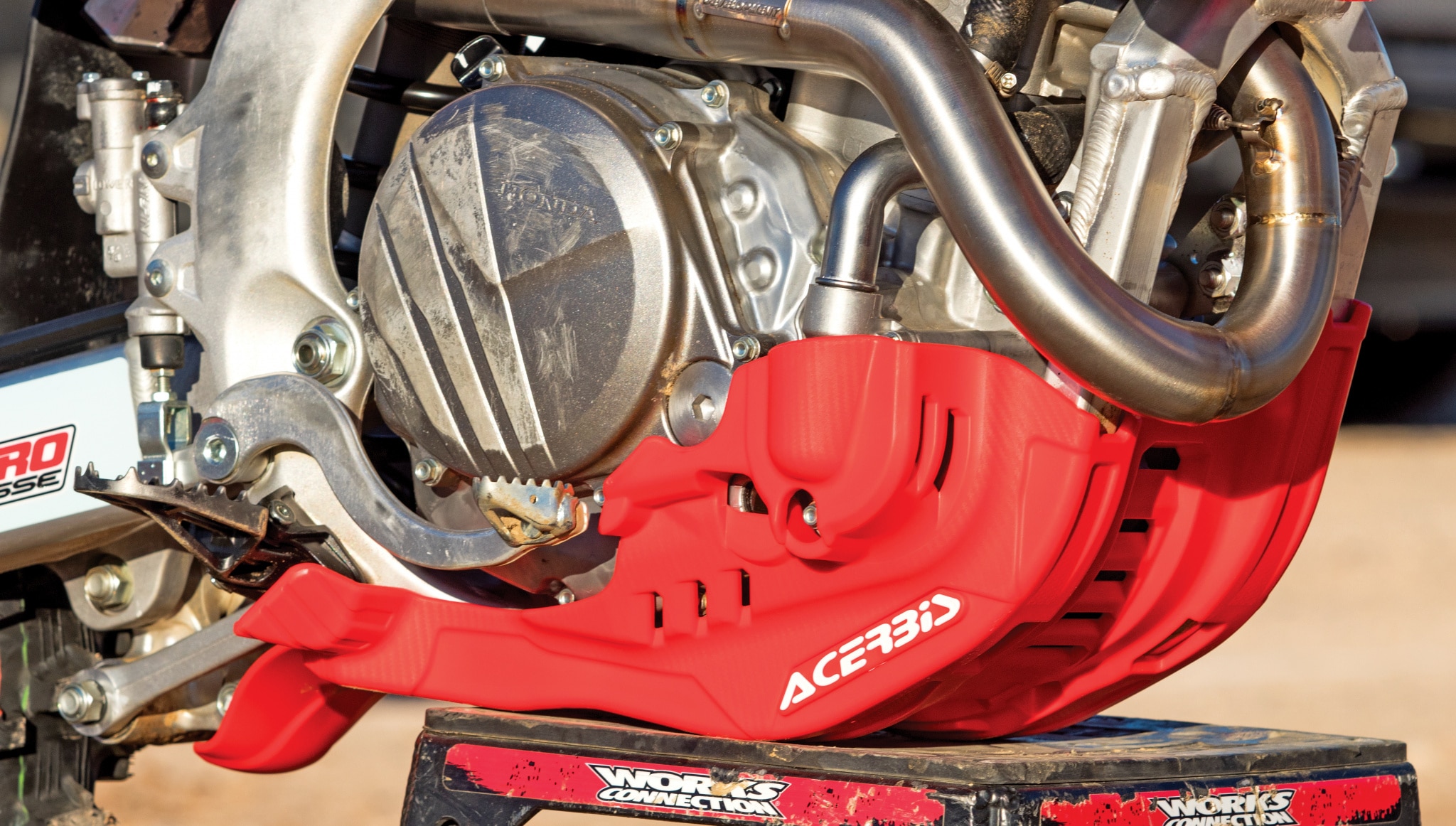 The Acerbis skid plate offers supreme protection on both the Honda and Yamaha.
The Acerbis skid plate offers supreme protection on both the Honda and Yamaha.
(6) Protection. Acerbis provided a full-coverage skid plate that protected the undercarriage as well as the water pump, the front of the clutch cover, the bottom of the footpegs and the shock linkage. I also used Acerbis X-Future hand guards to protect my hands. After all, my hands are my moneymakers, since half of my job is documenting our test results on the computer.
(7) Muffler. Pro Circuit provided a stainless steel T-6 exhaust system that added some power throughout the curve and made the bike look and sound like a racer.
(8) Start device. Although they use a green-flag start, I still wanted to have a Works Connection Pro Launch start device in case I got over-zealous with the throttle.
(9) Seat cover. One of the first aftermarket items I put on my race bikes is an aggressive gripper seat cover. The Guts Racing Wing seat is not only pleated for extra grip, it also has bulging 1-inch wings on each side that allow my legs to dig into the bike for much better grip. I also had Guts give me a seat bump to further keep me planted on the bike, saving my legs and arms.
(10) Fuel. ETS is known for making the ultra-potent fuel for the factory KTM, Husky and GasGas teams, but they do more than just factory bikes. ETS has a full line of fuel for different price points and purposes. We used the ETS ExtraBlaze 97. It’s like pump fuel but slightly higher octane. It ran clean and smooth on both of MXA’s 450s.
(11) Chain. We added a stock Honda CRF450 520MX chain to replace the heavy-duty stock chain to make sure there wasn’t any extra drag on the engine during acceleration and, more important, to create more free-rolling deceleration.
(12) Graphics. Factory Effex dressed the CRF450FX with blue backgrounds and yellow numbers, which is required for the 450 Pro class at WORCS.
2022 YAMAHA YZ450FX
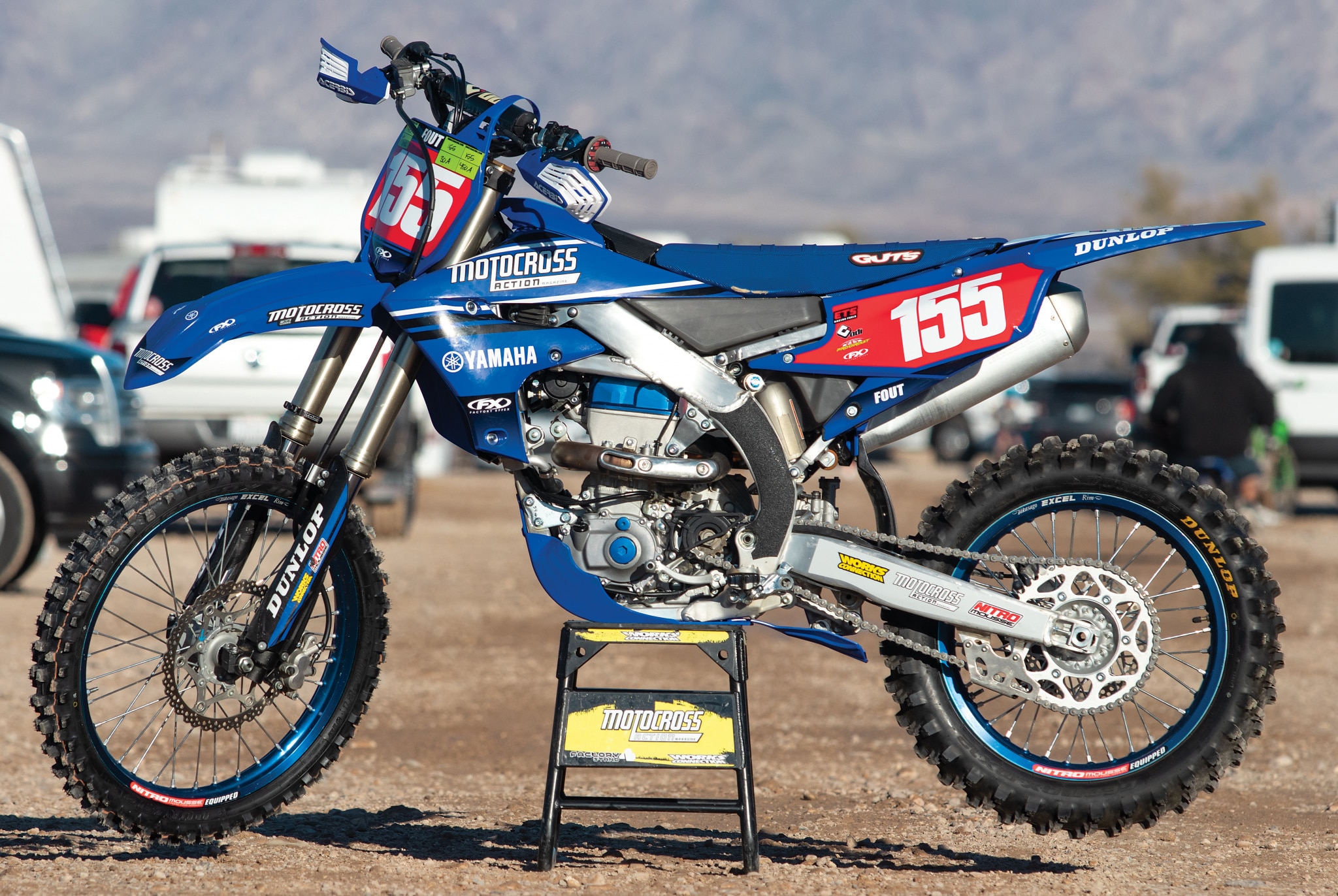 MXA’s Josh Fout and Josh Mosiman put the CRF450RX and YZ450FX to the ultimate test on a grueling sand track.
MXA’s Josh Fout and Josh Mosiman put the CRF450RX and YZ450FX to the ultimate test on a grueling sand track.
Q: WHAT MAKES THE 2022 YAMAHA YZ450FX CROSS-COUNTRY MODEL DIFFERENT FROM THE YZ450F MOTOCROSS MODEL?
A: The Yamaha YZ450FX is actually changed more from the 2022 YZ450F than the CRF450RX is from the CRF450. For the most part, the same basic items have been changed (i.e. 18-inch wheel, big tank, etc.). But, the big kicker is the wide-ratio tranny. Here’s a list of the parts that set the 450FX apart from Yamaha’s YZ450F motocross model.
(1) Tank. Yamaha and KTM do a great job with their oversized tanks. The FX tank is 2.2 gallons, up from 1.6 gallons, and hides the added fuel capacity low and in the back.
(2) Rear wheel. For more comfort and bump absorption, the FX comes with an 18-inch rear wheel instead of the 19, but the tires are the same as on the YZ450F. The FX comes with Dunlop MX33s.
(3) Price. The YZ450FX retails for $9899, while the YZ450F is $9599. These are the exact same prices as the Honda CRF450RX and CRF450.
(4) Skid plate. The FX comes with a full-coverage skid plate, while the motocross bike doesn’t come with one.
(5) Transmission. Surprisingly, the FX comes with a wide-ratio transmission. Oddly enough, it’s the same tranny that Yamaha’s WR450F uses.
(6) Mapping. The FX has custom mapping made for this transmission and off-road riding. It’s ultra-linear, providing more rear-wheel traction.
(7) Idiot light. The YZ450FX has a nifty little low-fuel warning light on the handlebars.
(8) Chain. It comes with a sealed O-ring chain.
(9) Kickstand. The FX doesn’t have hand guards, but it does have a kickstand.
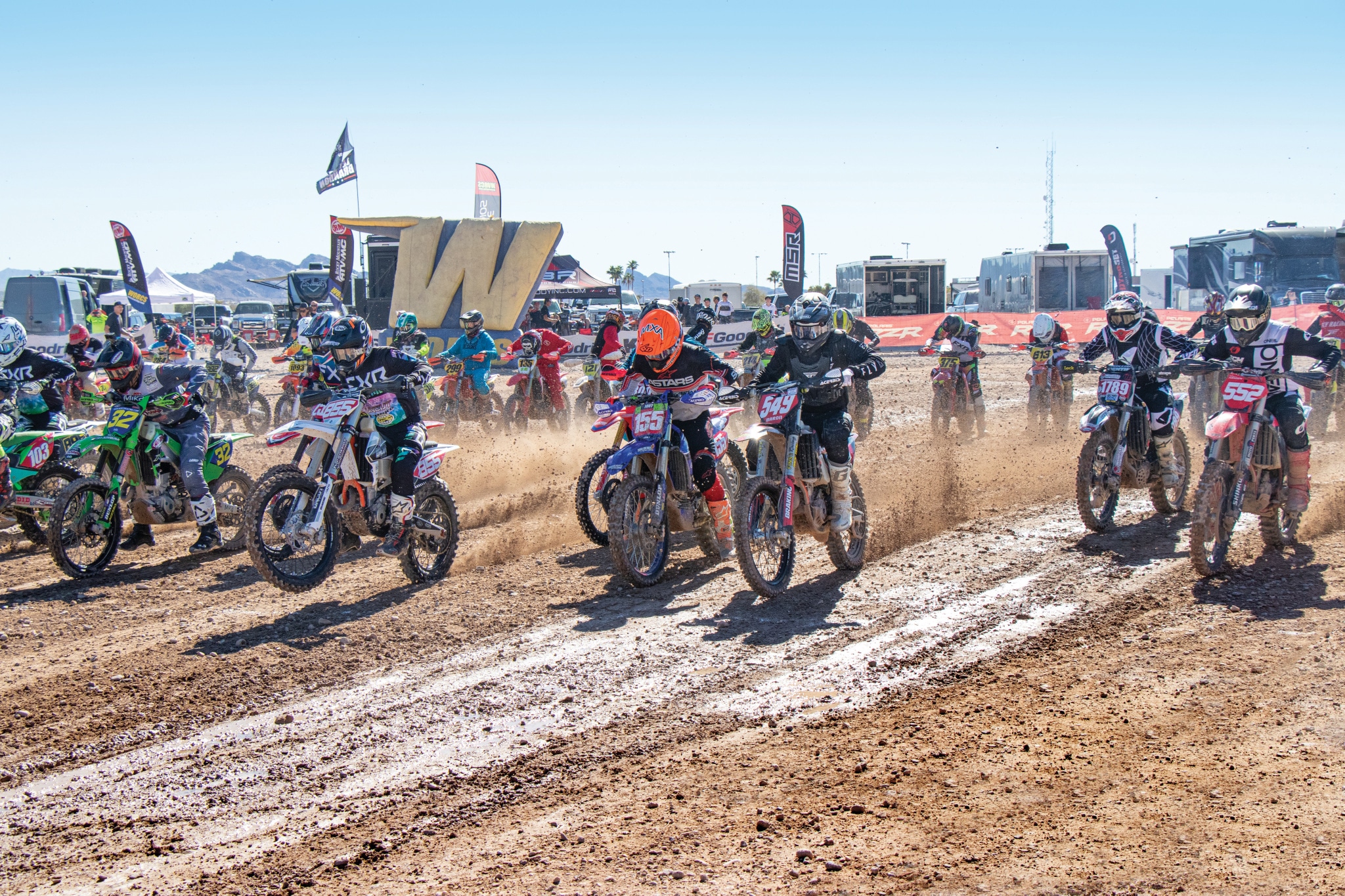 Josh Fout (155) blasts off the line in the first of his three races on the 2022 Yamaha YZ450FX at Lake Havasu. The Yamaha held up beautifully until being taken out by another rider in his third race.
Josh Fout (155) blasts off the line in the first of his three races on the 2022 Yamaha YZ450FX at Lake Havasu. The Yamaha held up beautifully until being taken out by another rider in his third race.
Q: WHAT ARE THE 2022 YAMAHA YZ450FX’S STRENGTHS?
A: We love how stable the YZ450F is, and we appreciate how comfortable the Kayaba SSS forks are as well. For the 450FX, straight-line stability is the selling point. Even though the off-road-specific suspension settings were too soft for Josh Fout, this bike still felt predictable on long, rough straightaways. The 18-inch rear wheel allows for a larger Dunlop rear tire, which means more rubber and better bump absorption.
The wide-ratio transmission was another plus on the YZ450FX. For Grand Prix racing, we never ran out of gears. And, surprisingly, the tranny worked well for motocross racing, too. The engine had enough power to pull third gear in almost every corner, and third gear was long enough to stay in for most of the straightaways and hills. On the wide-ratio tranny, first gear was a granny gear we never needed for our motocross and Grand Prix adventures.
Working in conjunction with the well-appointed transmission and stable chassis is the smooth Yamaha engine tuned for the off-road with GYTR mapping. The YZ450FX powerband is a toned-down version of the YZ450F. That makes it easier to ride. It doesn’t flame out at low rpm. It has great rear-wheel traction. It inspires confidence. It is also compatible with the same Yamaha Power Tuner smart phone app. It allows the riders to connect to the bike via Wi-Fi to adjust map settings for the air/fuel mixture, ignition timing and engine decel braking. It can also be used to check engine codes and track how many hours are on the engine.
 Josh Fout on the gas through the sand rollers.
Josh Fout on the gas through the sand rollers.
Q: WHAT ARE THE 2022 YAMAHA YZ450FX’S WEAKNESSES?
A: The YZ450FX is tough to turn. In contrast to its marvelous straight-line stability, cornering is not this bike’s strong point. In general, MXA test riders feel most comfortable turning Yamaha 450s when there’s a berm to bank off of. Cornering the YZ450FX is not always a pretty thing to watch. We often go out of our way to find something for our wheels to lean into. This can be helped through testing and proper bike setup, but it’s not a natural inclination for the YZ450FX.
The fuel tank location is a strength of the stock YZ450FX. With Yamaha’s unique backwards engine concept, the airbox is positioned where the fuel tank normally sits, and the fuel tank can be found where the airbox normally is. The swap is good for centralizing mass and, as noted, even with an oversized 2.2-gallon tank, Yamaha has room to keep the fuel in the same area underneath the seat; however, a problem arises when you add an even bigger tank and a quick-fill cap. Since the stock fuel cap is hidden underneath the front of the seat, the aftermarket quick-fill cap ends up replacing the flip-up section at the front of the seat, making for an uncomfortable experience when turning. Luckily, Josh Fout’s A-class races were only an hour long, which meant that he didn’t need a bigger tank or a quick-fill pit stop. The stock tank and seat were great for our testing and racing.
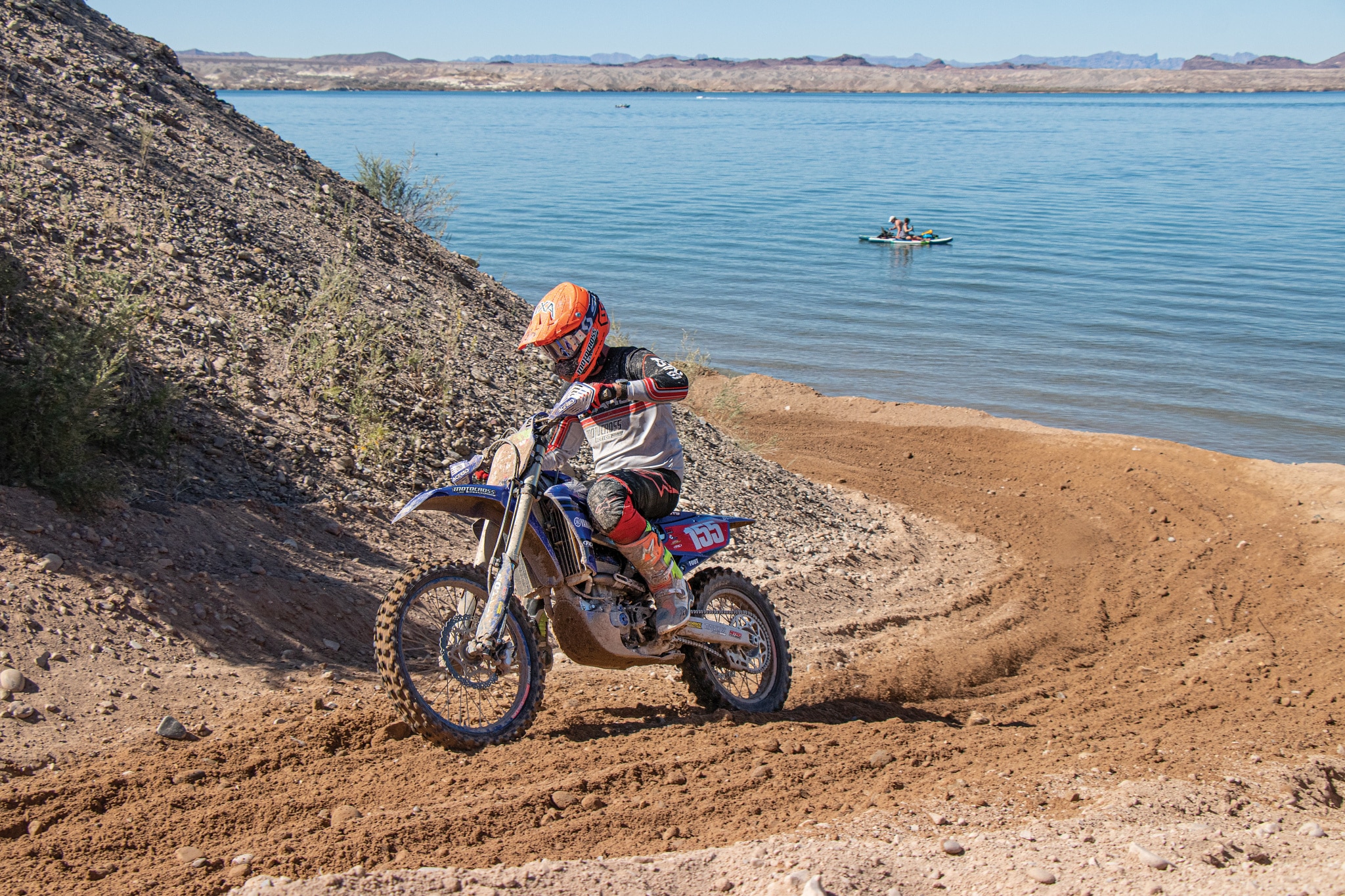 You might be surprised to know the YZ450FX has a wide-ratio transmission. It worked okay in motocross, too.
You might be surprised to know the YZ450FX has a wide-ratio transmission. It worked okay in motocross, too.
Q: WHAT DID WE MODIFY ON THE YZ450FX FOR GRAND PRIX RACING?
A: Compared to my CRF450RX, we spent a little less money modifying Josh Fout’s YZ450FX race bike with aftermarket parts; however, Josh did find some sneaky “free fixes” to tailor the Yamaha for him.
(1) Free traction. Multiple people spotted a missing bolt on our YZ450FX when walking through the pits. They took great pride in their discovery and were happy to point it out. To their surprise, the bolt was removed on purpose! Josh Fout removed the bottom bolts out of the top triple clamp in a shade-tree engineering attempt to get the YZ450FX to handle better. He said it gave him a more precise front-end feel coming into turns; however, we don’t recommend this mod. MXA test riders often try stupid things; that doesn’t mean you should. We made sure that Josh torqued the remaining triple clamp bolts to 25 N/mm.
(2) Slim fast. The YZ-F models have the widest radiator scoops on the market. It is not the actual width in inches that makes them feel bulky. Instead, it is how quickly they flair from seat width to radiator width. It is such an abrupt change that the feeling at the rider’s knees makes the Yamaha shroud feel so much wider. To help, we flip the radiator spacers between the frame and radiators around to bring each shroud in a 1/2-inch.
(3) Flat-free. After putting some wear and tear on the stock tubes, we installed Nitromousse foam tubes front and rear to eliminate any chance of getting a flat tire. Running mousse tubes is essential in off-road racing, because you’re riding over rocks, trail debris and harsh bumps that are often hidden in the shadows.
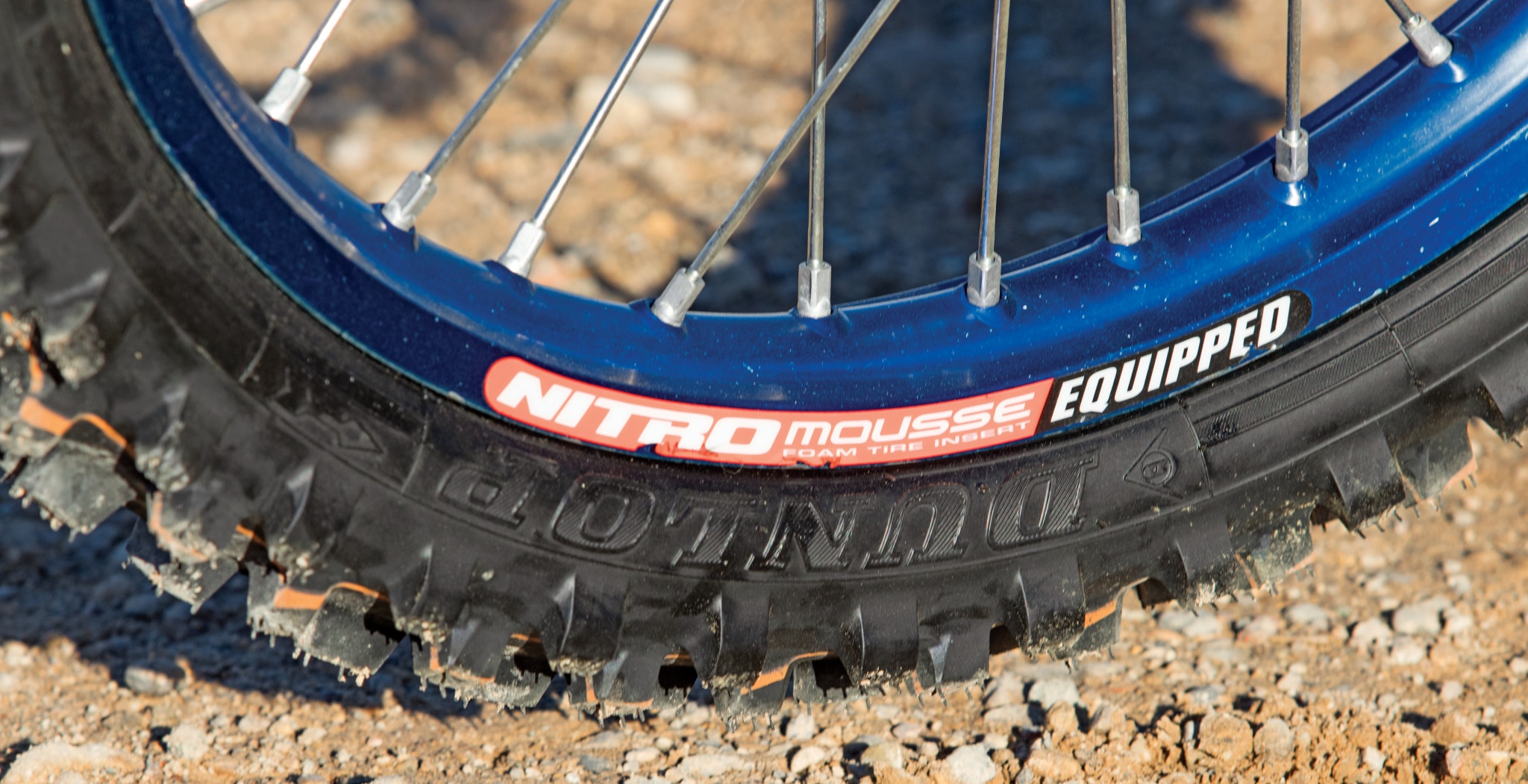 Nitromousse took care of both bikes, ensuring no tire issues on the rocky Lake Havasu shore.
Nitromousse took care of both bikes, ensuring no tire issues on the rocky Lake Havasu shore.
(4) Engine mounts. We found that the YZ450FX actually has an optional “secondary” front engine mount that the YZ450F doesn’t have. We took the secondary moto mount off and gained more flex in the chassis for steering and bump absorption.
(5) Tires. Like on the Honda, we used a Dunlop MX33 front tire and the MX12 sand/mud scoop tire in the rear for Lake Havasu. With the MX12 on a 450, you never need to fan the clutch in a deep sandy turn. Just twist the throttle and go.
(6) Handlebars. The stock YZ450FX handlebars were a little tall (and Josh Fout is tall). We ran ODI’s CFT handlebars in a lower bend. The CFT bars have extra flex to help absorb the bumps in the choppy sections.
(7) Clutch perch. Yamaha and Suzuki are the only manufacturers still using cable clutches in their 450s. We used a Works Connection EZ Pull clutch perch assembly and lever to smooth out the clutch pull. It made the clutch easier to adjust and made the setup predictable.
(8) Suspension settings. The stock KYB suspension setup on the YZ450FX is great for slow, technical terrain but too soft for high-speed West Coast Grand Prix racing. Although Josh had the option to change his spring rates and valving, he left the suspension stock and adjusted the clickers and preload. He turned the fork compression all the way in and then out two clicks and set the rebound on 10 clicks out with the fork height 5mm above the top triple clamp. In the rear, Josh set the low-speed compression on 6 clicks out, rebound on 11 clicks out, high-speed turned 7/8ths of a turn out and the sag at 105mm. Yep, we cranked in on practically everything.
RACING AT, OVER & THRU LAKE HAVASU
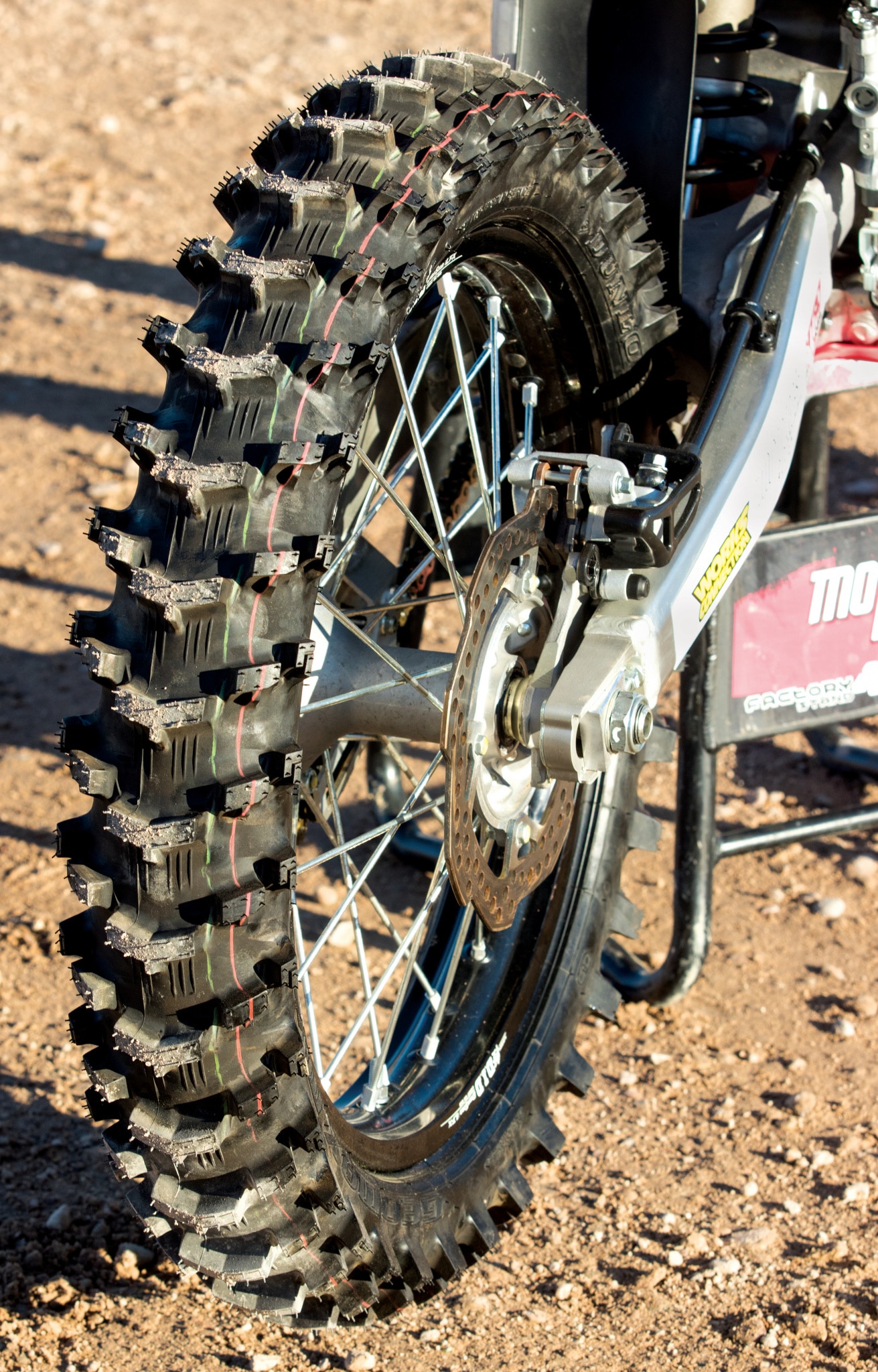 The Dunlop MX12 sand tire is a must-have for the rolling sand whoops around the lake.
The Dunlop MX12 sand tire is a must-have for the rolling sand whoops around the lake.
After testing our cross-country bikes in stock form on our local tracks and trails, installing mousse tubes, putting on new graphics and making one last run-through with a torque wrench, it was time to start driving towards Lake Havasu. I signed up for the two-hour-long 450 Pro race, which was schedule to start just before lunch on Sunday, while Josh Fout signed up for the 30+ A, 450 A and Open A classes, each being one hour long.
I first raced the Lake Havasu WORCS race in 2016, and, even though it’s always been pure torture, I’ve been back three more times since then. There are a few aspects that draw me and Josh Fout to this race. Probably the biggest pull is the track. It’s difficult to find a sand track in California that develops rolling sand whoops all the way around the corners. They are out there but mostly hidden away in sand washes or secret test tracks, not at the local motocross track where they hold races in the Golden State. This type of roughness separates the men from the boys. The second draw is the location. The Havasu track has sections that ride on the beach and, as always, there’s the famous Lake Havasu Lagoon Jump. This year the water drew even more attention, as the organizers sent the Pros down a 30-foot sand cliff straight into the lake and around a wooden stake positioned in about 3 feet of water. The track is also right next to downtown Lake Havasu City and the main port where pleasure boats dock.
The negatives of racing the Lake Havasu track probably exceed the positives. With the location and setting, they don’t have enough room to make long lap times. For the fast Pros, it takes about five minutes to get around. This makes a two-hour race feel like an eternity. There’s also an abundance of rocks. When you’re not plowing through deep sand, you’re riding on hardpack dirt and skating over small and large rocks. But, about a month after the race, once your body is finally recovered, you’ll forget about the rocks and the hardpack sections and only remember the other 50 percent of it that is rough (but fun) sand rollers.
The 2022 WORCS race was only Josh Fout’s second adventure at Lake Havasu. I should also mention that Josh is MXA’s huckleberry for just about anything. He races almost every weekend of the year, either motocross, Grand Prix, enduro, desert, EnduroCross or other off-the-radar events, which means he helps us gather valuable information for bike tests. He is also willing to test any product we give him, fix anything that breaks, and be MXA’s fill-in rider for photo and video shoots.
Josh realized that sticking with the stock YZ450FX suspension was a mistake. Lake Havasu isn’t a high-speed track with chatter bumps like many tracks where Josh rides. Havasu has many sections that are actually slow speed, with big braking bumps and lots of acceleration bumps out of the corners. This year, the Lagoon Jump was bigger than I’ve seen in my four trips to this race. Josh jumped it a few times during his three races, but with deep sandy ruts up the face all the away to the lip and the watery lagoon waiting for any errant rider and a peaky landing, Josh took the “Chicken Line” around the Lagoon Jump, even though it added 15 seconds. Josh ended up fifth in Open A, seventh in 30+ A, and a DNF in 450 A after being taken out by another rider. As for the Chicken Line, he was okay with taking it because he lived to fight another day. I didn’t chastise him for not jumping it. He had raced three grueling hours at Havasu, and I was glad that he was healthy enough to help me with my mid-race pit stop.
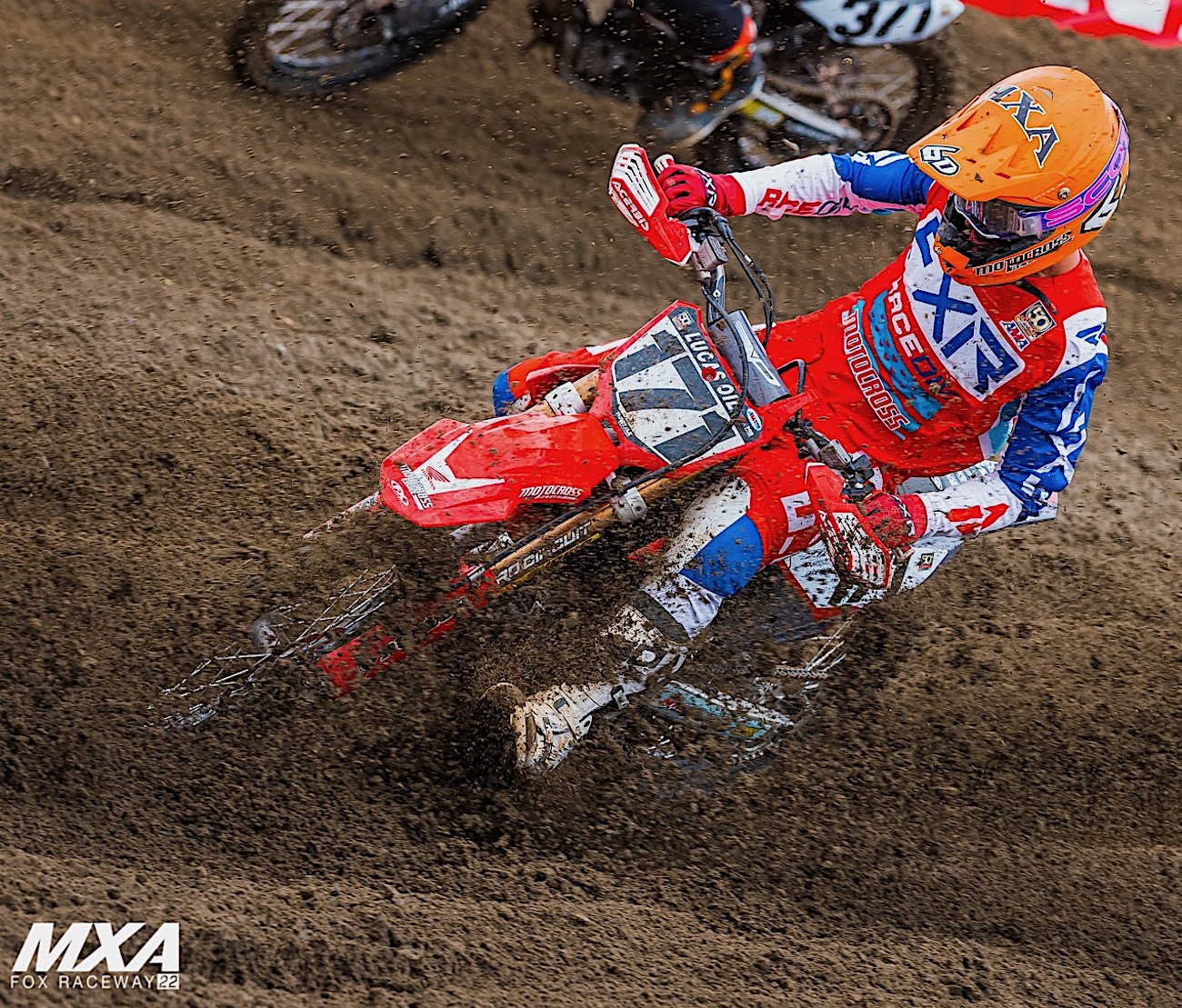 Believe it or not, Josh Mosiman raced the AMA 450 National at Pala on the same Honda CRF450RX that he raced at Lake Havasu (with a few mods) after his CRF450 Works Edition engine blew up in practice.
Believe it or not, Josh Mosiman raced the AMA 450 National at Pala on the same Honda CRF450RX that he raced at Lake Havasu (with a few mods) after his CRF450 Works Edition engine blew up in practice.
With Pro Circuit suspension and exhaust, Nitromousse tubes, my Guts Racing gripper seat, Dunlop MX12 scoop tire and more, I had zero complaints about my CRF450RX. When I had the strength to ride it properly, the RX was stable over the bumps and ultra-fun to rail through the sand berms. The first laps through the water were the most nerve-wracking moments of the race for me. I had planned to cover the massive Honda air box vent hole before the race to ensure I didn’t suck any water, but in my hectic last-minute prep of my goggles and hydration pack, and my haste to drink and eat as much as I possibly could, I forgot to tape it up. Thankfully, after soaking everybody on the first few laps, the promoters moved the turn closer to the beach, realizing that the run-up to the Lagoon Jump could be deadly if anyone’s bike sucked water on the face of the jump.
The two hours were brutal. I never expected to win against the best off-road riders in the country, but I thought I would hold my own a little longer than I did. My strength failed me about 35 minutes into the race. It felt as if the WORCS promoters were trying to torture us. As usual, they positioned a large digital clock right next to the single-file finish-line chute. They intentionally slowed you down to first gear to go past the timing and scoring line. Keeping your eyes away from the clock was nearly impossible.
I felt great until I accidentally looked over and saw how much time had elapsed at the 35-minute mark; it broke my spirit. I got passed by two riders and struggled to find my footing again. Eventually, I found some pace and kept it for the next 45 minutes. I battled back and forth with Austin Politelli (another motocross guy who was giving off-road a shot this weekend) for eighth place in the 450 Pro class. I had the spot until three laps to go, but at this point I was broken. Austin Politelli got me back on the final lap with a couple turns to go.
In the end, I finished ninth in the 450 Pro class, and my body wasn’t the same for a week. The Lake Havasu City WORCS race is a humbling experience. I plan to be back again next year.


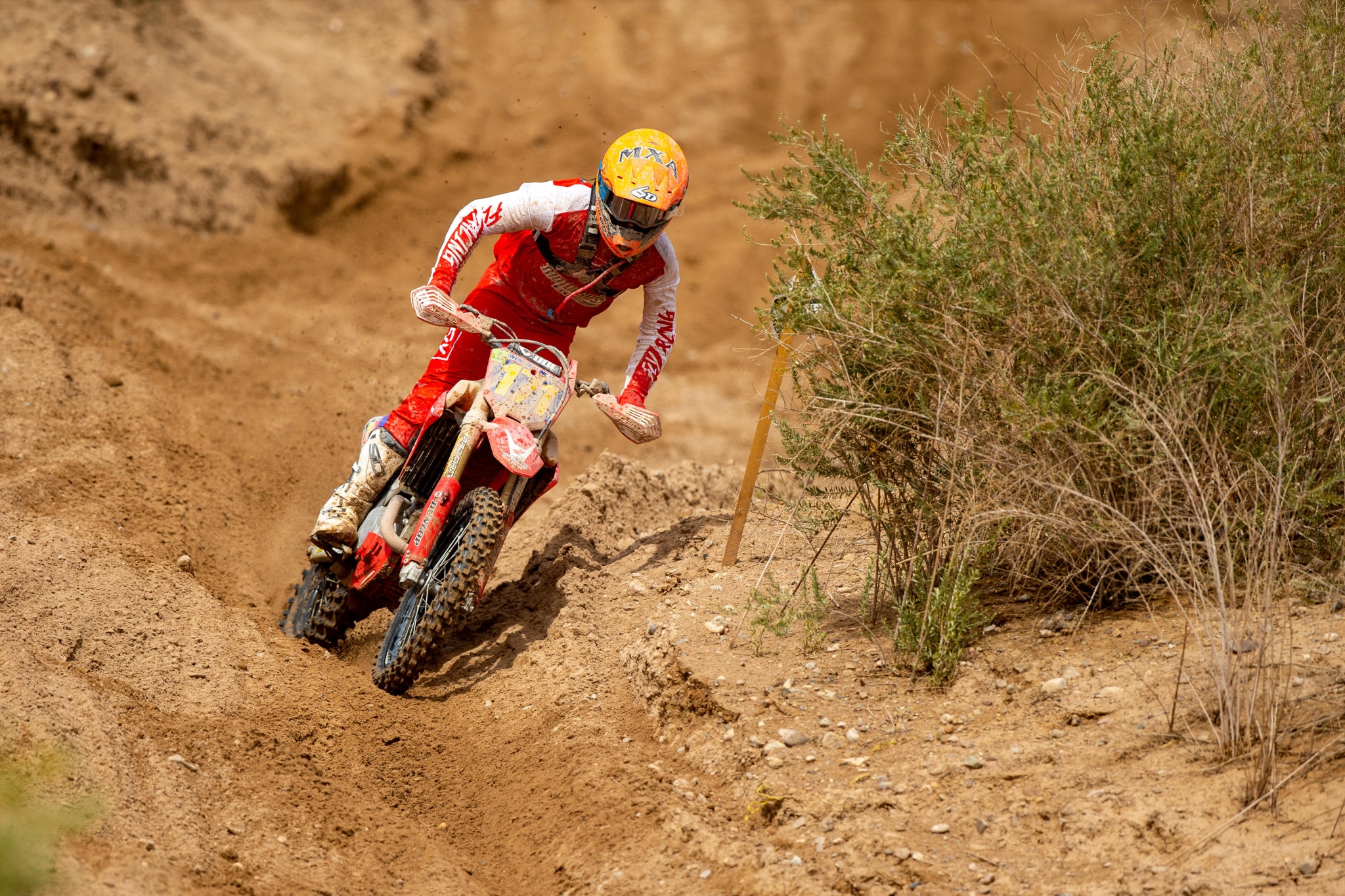

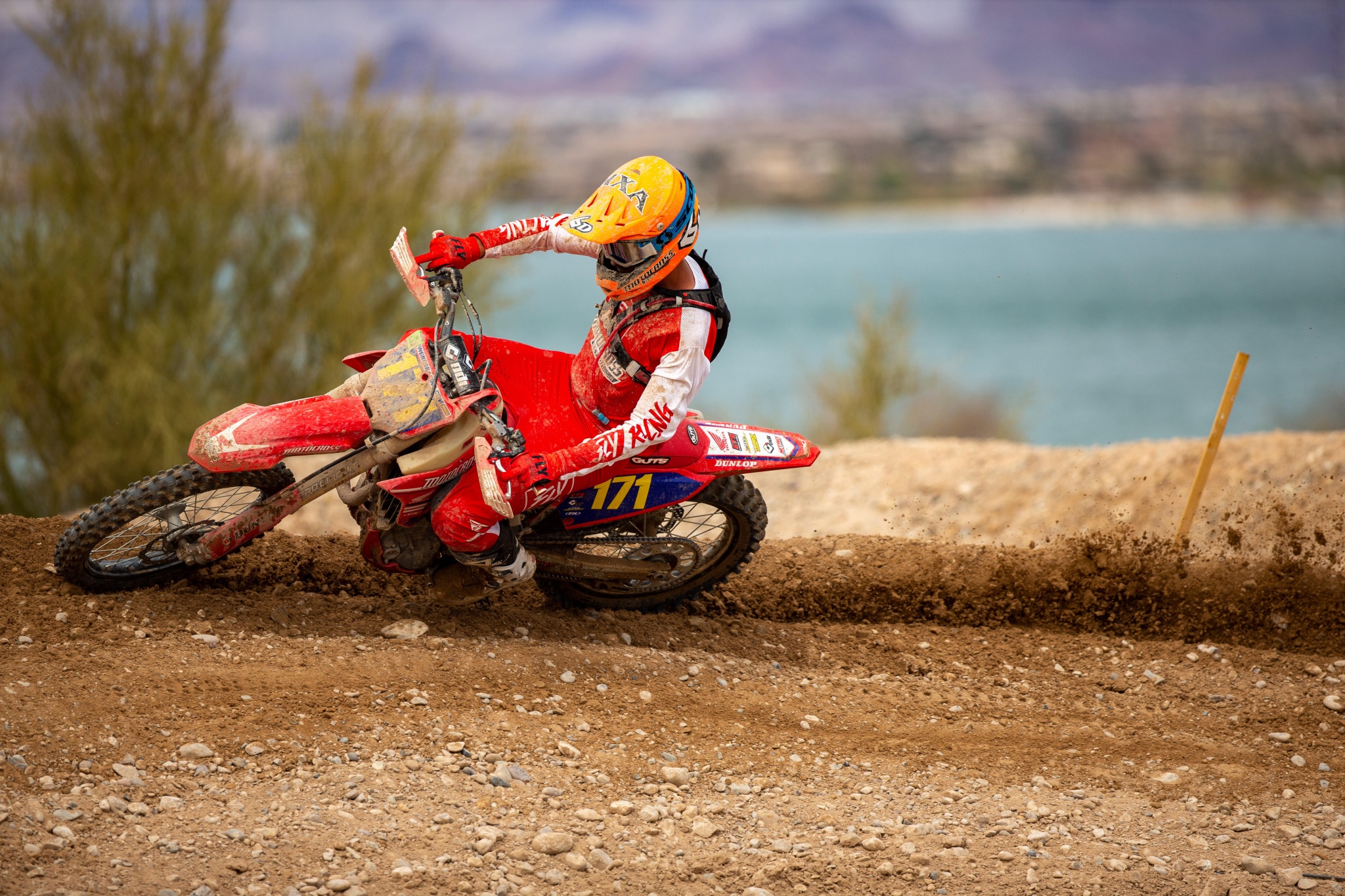




Comments are closed.